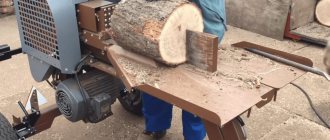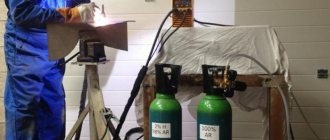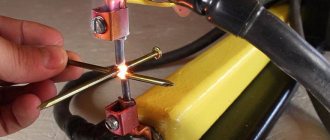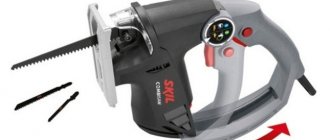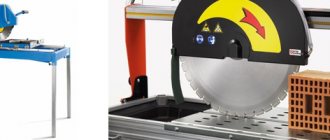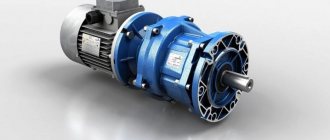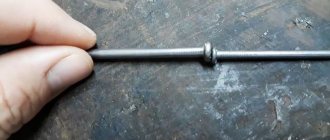For a physically developed person, chopping wood is more pleasant than a burden. And, of course, it is useful: this activity harmoniously loads all muscle groups. But what is too much is not healthy. If chopping wood is exhausting and/or leaves no energy for other household chores, then a wood splitter is, of course, needed on the farm. However, in this case it is hardly advisable to select a prototype based on the technical features of well-known industrial products, if only because there are dozens of varieties of their designs and the use of each requires safety measures that are not always feasible at home. Therefore, in order to make a wood splitter with your own hands, you must first determine for what purpose it is needed:
- For regular preparation of large quantities of firewood for heating a large house in a harsh climate;
- The same, but the house is small and/or located in a place with mild winters, i.e. little firewood is required;
- For irregular preparation of firewood as additional fuel (for example, to coal) or for heating utility rooms;
- For occasional preparation of firewood for decorative heating devices (eg fireplace) or for heating a winter weekend cottage.
Hit or push?
Splitting wood chips is considered a dangerous production process: a blank that turns out of the machine can flatten a person, and flying wood chips can pierce him through. It is impossible to completely exclude emergency situations when chopping wild wood - in this regard, it is far from a completely predictable material. As a result, some types of technical classification of devices for splitting raw wood need to be kept in mind in order to make a wood splitter that is safe enough for everyday use. Namely, whether it is a shock action or a pressure action:
- Mechanized impact splitters with intermediate energy storage are highly efficient, economical, and almost completely relieve the operator of muscular effort, but they are structurally complex and the most dangerous in operation. They cope with any kind of fools, incl. with butt ridges of elm and larch.
- The same, manual ones without a mechanical energy accumulator - non-volatile, cheap, and structurally simple. They can be used in pressure mode and thus split twisted and knotted wood up to 25-30 cm in length. They require less muscular effort, and work safety is higher than when manually chopping with a cleaver on a block. Low productivity; suitable for irregular and occasional preparation of firewood.
- Push splitters driven by an internal combustion engine or an electric motor are quite expensive (see below). Also, the muscular efforts of the operator are almost completely eliminated. The productivity is sufficient to regularly supply firewood to a house of up to 200-300 sq. m in winter with frosts down to –40 and below. The highest possible security is achievable for this class of devices. Disadvantages are the complexity of the design and fairly high energy consumption in the form of electricity or liquid fuel.
Note: churak (forestry term) is unprocessed timber without butt and crown or part of it. The use of colloquial synonyms churbak, churban and churka is certainly legitimate if there are no discrepancies in the context.
Why - don't hit
In mechanical impact wood splitters, a relatively weak engine spins the flywheel through a fluid coupling. Thus, the engine operates almost all the time at optimal speed and consumes a minimum of fuel/electricity. Then a crank with a pusher is engaged with the flywheel (hydraulic or frictional), feeding the block to the splitting knife. The impact force is colossal: more energy can be “pumped” into a flywheel with a diameter of 60-80 cm than in a 100 kg aerial bomb. Churak actually does not split, but is cut with a knife, despite any defects in the wood.
Abroad, where energy resources and high-quality straight-layer wood are expensive, household mechanical impact wood splitters are produced and are in demand, see photo at the beginning. There are no imports of such devices into the Russian Federation, and industrial ones are finalizing their resources and analogues to replace them are not being developed. The reason is that they are extremely dangerous. Modern composite superflywheels do not burst, but it is impossible to stop the push from the flywheel and thereby prevent the development of an emergency situation into a threatening and dangerous one. Therefore, further in the article mechanical impact wood splitters with energy storage are not considered.
DIY hydraulic wood splitter
This is not the simplest or cheapest, but it is quite powerful and very productive, almost eliminating manual labor when chopping wood. All you need to do is install the logs on the platform and collect the finished firewood in the woodpile.
This scheme uses completely ready-made components - oil tank and pump, motor, hydraulic cylinder, blade. Only the frame with the pusher is manufactured independently.
In a more detailed diagram, you can clearly see where the weakest point of the product is - where the cylinder stop is located
It is here that a poorly welded stop along with the cylinder is most likely to be torn off the frame, so the seams in this place should be treated with maximum attention
This is what the finished model might look like.
As you can see from the photo, the knife in this case is made of springs, sharpened at an angle of approximately 60 degrees. The pusher is welded from metal plates 5...10 mm thick, the frame is assembled from an angle and a channel. You will have to select the necessary rolled metal products yourself, based on the available reserves.
The main parts and components of the device are presented in the assembly diagram.
Here:
- bed;
- cleaver (knife);
- wheels (optional, if necessary, periodically move the machine);
- a carriage pushing the block onto the knife;
- hydraulic cylinder;
- hydraulic type distributor with a lever, it operates the machine;
- hydraulic pump (model NSh-32);
- tank for filling liquid (oil), volume 32 l;
- hydraulic pump drive shaft with cardan;
- drive shaft housing;
- electric motor (model AIR80V2);
- turntable;
- drive pulley;
- driven pulley;
- drive belt.
This is what the bed may look like in this model.
Carriage assembly.
Turning platform.
Transmission mechanism.
The device is assembled.
This video describes how to make a homemade hydraulic wood splitter.
It couldn't be simpler
The simplest non-volatile manual wood splitter is nothing more than a splitting axe. If you use it little by little, but regularly, so that you develop skill and eye, then it is even safer than mechanical and mechanized ones and more productive than the former. Provided that the configuration of the cleaver and the ax is optimal and consistent.
The splitting ax has undergone a long evolution and continues to improve. On the right in Fig. a drawing of the Strela cleaver, adapted for manual splitting of knotty and twisted ridges, is given; on the left are axes for it (the cleaver is attached to it with a wedge). With the ax handle as you wish, whether you like to swing the ax or not, but the cleaver itself will still be very useful to us, see below.
Drawings of a wood splitting cleaver Arrow and axes for it
But what not to do
A dangerous way to manually split wood
For several years now, a Finnish farmer’s discovery has been circulating on the Internet: chopping logs for firewood in a tire, see fig. on right. It is not clear why it is good that the split lump will not fall apart, but will remain sticking out in the shell. But something else is clear. If, when chopping wood normally, you smear a cleaver instead of a block on the block, the ax handle will hurt in your hands. You might not even be able to stand on your feet and hurt yourself. But if you miss the rubber with the same cleaver, you can get hit on the forehead with the butt. So don't. The wood splitter tire is a curiosity, but not at all useful.
Product Features
A wood splitter is always useful on the farm; you can either buy it ready-made or make it yourself using available materials. Ready-made options have been improved; there are a number of additional functions that allow you to chop maximum firewood in a short time.
There are many installations operating in an automated format. This is good, because you can not waste time on work, but start a machine that will do everything itself. Experts identify several characteristics that can be used to classify mechanisms into categories:
- Depending on the method of stacking logs, machines can be vertical or horizontal. Sheer structures are considered more powerful and durable, since they can process even a thick deck in a short period of time. If the logs are crooked or have many irregularities, then it is better to give preference to the horizontal mechanism.
- Maximum amount of stacked firewood. Depending on this criterion, equipment can be divided into equipment for home use and for industrial use.
- Drive types. For home use, a machine with a low power electric type is suitable.
In this video we will look at a hydraulic wood splitter:
When you need a lot of wood
For mass preparation of firewood, push-type wood splitters with a hydraulic or mechanical rack pusher and a stationary working body - a splitter - are used. The pusher pushes the block onto the cleaver, which splits it into 2, 4 or 8 segments suitable for loading into the furnace firebox. In both cases, the speed of feeding the block onto the cleaver is determined most of all by the properties of the wood and is 4-5 cm/s. To prevent the engine from “losing speed” during the reverse stroke of the pusher and consuming too much fuel/electricity, the reverse stroke speed is set to 7-7.5 cm/s. In this case, you can prepare up to half a ton or more of firewood in the morning.
Note: do not chop raw, freshly chopped churaki into segments. For a year they should dry from the ends in a separate section of the woodpile or woodshed. If you chop logs that are still oozing juice onto firewood, the wood will lose up to 15-20% of its calorific value during further drying. And you, respectively. money for fuel.
More about safety
A homemade wood splitter can be made similarly to factory ones with horizontal or vertical supply of wood, see figure:
Wood splitters with horizontal and vertical feeding of wooden logs
Vertical type wood splitters are more compact and allow the use of a more durable U-shaped frame. However, the probability of ejection of cross-layered, knotty, twisted, crooked and/or non-parallel cuts or its fragments from a vertical wood splitter is much greater than from a horizontal one; the side paws are here, as they say, for peace of mind. In addition, the operator of a horizontal wood splitter is normally located outside the area of scattering of parts of the log in an emergency situation; he can only be hit by a ricochet. In a vertical wood splitter, the debris scattering zone is almost circular and people around it are directly affected by them with full force. Therefore, it is better to make a horizontal wood splitter with your own hands from random materials at hand, and a vertical one only when there is very little suitable space. A typical case is a stationary wood splitter with an electric drive. It cannot be left outdoors due to safety requirements, but a vertical one can be placed in a woodshed.
Hydraulic
The hydraulic wood splitter in this segment is the most economical and productive. This is determined by the external characteristics of the hydraulic drive, see below, and by the fact that the hydraulic pump drive motor operates in a stable mode. The device diagram, appearance and diagram of a hydraulic drive with one pump are shown in the figure: the drive motor rotates the hydraulic pump, which pumps oil from the tank into the system, and the distributor supplies it to the cavities of the forward and reverse hydraulic cylinder.
Diagram of a hydraulic wood splitter
A significant drawback is that the owner-operator must be skilled in operating and maintaining hydraulic systems. Less significant is the need to periodically change the oil, which costs money. Another drawback (in this case a small one) is that the motor power is taken away both in forward and reverse, therefore, if the components are available (see below), craftsmen sometimes make hydraulic systems with 2 pumps for forward and, low-power, for reverse, see . video clip:
Video: homemade hydraulic wood splitter
Note: it is quite possible to make a vertical hydraulic wood splitter with your own hands, see the video below:
Video: vertical hydraulic wood splitter
The safety of the hydraulic splitter is average: there is no return spring, and the switching time to reverse is quite long - about 0.5 s for the best branded designs. During this period, the “harmful” block may have time to burst and fly apart, even if the operator is experienced and his reaction is instantaneous.
Make or buy?
Hydraulic wood splitter with additional functions
The first thing you need to decide if you already like a hydraulic splitter is whether it’s better to buy a ready-made one with a guarantee? A good diesel fuel unit for double splitting straight-layered blocks up to 20 cm in diameter can be found for up to 20 thousand rubles. A device for splitting logs up to 30 cm with separate knots and strands into 4 segments (which is optimal for a stove) with adjustable splitting splitter height and automatic dumping of logs (see figure on the right) will cost up to 25-27 thousand rubles. For a high-performance wood splitter for splitting into 8 segments of knotted and twisted ridges up to 60 cm in diameter, you will have to pay more than 100-120 thousand rubles.
At the same time, a set of scattered units for a homemade hydraulic splitter will cost at least 60 thousand rubles. Even if you have parts of an old hydraulic system lying around in your shed, this is not an option. Firstly, worn-out hydraulic system components are difficult to repair. Secondly, the hydraulic cylinders of special equipment are designed for a higher feed speed than is optimal for chopping wood. Accordingly, the pump will have to be over-efficient, and the motor to drive it is obviously more powerful. As a result, either fuel consumption will be significantly higher, or the thrust will be weaker than that of the factory prototype.
If you do anyway
Let's say you have hydraulic system components from a mini-excavator or other mini-special equipment in your trash or you can buy them cheaply (these will do just fine). In this case, the hydraulic cylinder is selected (or the performance of the wood splitter is determined) based on the splitting force:
- Churak 20 cm in half - 2 tf straight layer; 2.7 tf is a bit knotty/wilted.
- Churak 25 cm – 2.3/2.7 tf, respectively.
- The same, for 4 segments - 3/4 tf.
- Churak 30 cm into 4 segments – 3.5/4.5 tf.
- The same for 8 segments - 4/5.5 tf.
- Churak 40 cm into 8 segments – 5.5 tf / 7 tf.
Next, based on the feed speed of 4 cm/s and the volume of the hydraulic cylinder, the performance of the hydraulic pump is determined and, according to the specification for the hydraulic cylinder, the appropriate pressure is selected. After this, a distributor is selected. Then the efficiency of the hydraulic system is set to 75% and the drive motor is selected for the required power with a margin of 5-10%. Additionally, based on the external characteristics of the drive motor, they look at its most economical speed and check whether they correspond to those of the pump. Hoses, valves and other fittings are selected according to operating pressure with a margin (for amateur design) of at least 50%.
Cleaver
The most important part of a homemade wood splitter is its cleaver. Hobbyists make it from old truck springs. In terms of the quality of the material, it cannot be better, but the spring leaves are slightly curved, which reduces performance and increases the risk of injury to the product. The best option is the top 1.5-2.5 cm of the heads of old rails. Convicts also really value railroad wheel tires and car buffers for their knives (they also went through a long cold hardening process), but they are less suitable for the configuration of a wood splitter.
Incorrect and correct designs of wood splitter splitter
The relative position of the cleaver knives is also very important. A horizontal knife protruding forward (on the left in the figure) immediately makes the wood splitter dangerous and, most likely, a thin straight-layered pine block will get stuck in it. The chock should be met with a vertical knife sharpened to a straight (symmetrical) wedge, pos. 1 in the center. The horizontal knife is positioned 15-20 mm posteriorly and is sharpened on the upper oblique wedge, pos. 2. It is very useful to equip the vertical knife with a piercing pin at the bottom (item 3 on the left) with a height of approx. 30 mm protruding approx. 20 mm forward. Such a cleaver will be better able to split clumsy logs if they are placed on the support with the flattest side down. The sharpening angles are:
- Vertical knife for soft and/or straight-grained wood (except birch) – 18 degrees (3 knife thicknesses).
- The same for hard fine-grained wood and birch - 15 degrees (3.7 knife thickness).
- Horizontal knives – 15 degrees.
- The needle is 22-25 degrees (2.5-2.7 knife thickness).
Rack and pinion
A rack-and-pinion wood splitter is cheaper than a hydraulic one: a branded one can be bought for 8-17 thousand rubles. Its device is shown in Fig. – the pusher on the rack is fed by a small gear-tribe (or tribe). The gear ratio from the motor to the tribe shaft is calculated using a feed speed of 4 cm/s.
Wood splitter device with rack drive
It is also easier to make a wood splitter with a rack drive with your own hands - the parts of a rack jack (you can use old ones) are quite suitable for the base. A rack-and-pinion splitter is also simpler to operate: maintenance of the hydraulic system is completely eliminated. Its safety is greatest: it is enough to release the pressure roller lever (or reflexively throw it out of fear), and the return spring will lift the rack above the bushing and throw it back.
The main disadvantage of the rack-and-pinion splitter is the poor external characteristics in this case (pos. P in the figure below): as the feed speed approaches zero, the stop increases sharply, and then also sharply drops to zero. That is, if there is a defect in the block in which the cleaver gets stuck, the drive will jerk strongly (which can cause its breakdown), and then the force of the tribe will be spent on pushing the rack away from itself, and not pushing it forward. It looks like this: the feed lever (if not released) beats painfully in the hand, the mechanism cracks, trembles, and may break. The initial section of the external characteristic of the hydraulic drive is soft: the greatest emphasis is created at zero feed speed. If a hydraulic splitter comes across a very stubborn chump, he will just as stubbornly push and shove him onto the splitting ax; maybe it will split.
External characteristics of the rack and hydraulic drive of the wood splitter
The first consequence of the rigidity of the initial branch of the external characteristics of the rack-and-pinion splitter is that more motor power is needed. Shift the splitting force values for the hydraulic drive in the list above by one position, and throw out the 40 cm block and 2/2.7 tf for the 20 cm one - get the initial data for calculating the rack drive; however, its efficiency can be taken as 0.85. Secondly, the internal defect of the block, which can slow down the cleaver, may also be the bark that has fallen into the split. As a result, the rack and pinion drive is more suitable for low-performance manual mechanical wood splitters (see below) with the adaptive external characteristic of the “motor” - our muscles.
Note: The poor external performance of the rack and pinion drive can be improved to some extent by a chain drive from the motor to the drive shaft, see below.
The simplest DIY wood splitter
cone wood splittersmetal cone with thread
In cases where it is not possible to order or make a cone on a machine, this part can be made with your own hands using a grinder. At the same time, there is no need to strictly maintain precise dimensions. In this case, you just need to first place the grinder on the electric motor pulley and evenly cut the metal, ensuring its free rotation.
The finished cone is put on a shaft with bearings of the required size, where at the end there is a flange with an asterisk from a scooter wheel. The threaded cone is attached to the shaft using a bolt or pin, this makes it possible to easily remove it from the shaft and unscrew it from the block when jammed.
A removed cone that is wedged in a log can be easily unscrewed from the wood using a gas wrench. If the cone is firmly fixed on the shaft, then, when jammed, it becomes necessary to remove the drive chain, since the motor shaft cannot always be turned in a different direction.
https://youtube.com/watch?v=qG_v8ZBSoVY
Manufacturing Features
The operating method of this screw log splitter is very simple. During rotation, the cone, like a self-tapping screw, is screwed into the log, splitting it. When working with a wood splitter, you need to be extremely careful and follow safety rules.
Types of wood splitters
Household devices only have the function of splitting logs. Professional devices have a very complex design that feeds wood, trims to a given length, splits and ejects chopped wood. Naturally, the price, performance, and power of these devices cannot be compared with conventional factory-made wood splitters, and even more so with your own hands.
According to the device for feeding split wood, wood splitters can be vertical, horizontal and combined.
In horizontal devices, the block of wood is mounted on a horizontal gutter. Moreover, taking into account the design, either the pusher moves the log towards the stabbing knife, or the knife moves along the guide towards the log.
In vertical wood splitters, the log is fed vertically, and a moving knife on top splits it. The mechanisms of this design are the most productive, they do not occupy such a large area, but they also have their disadvantages. So, during the operation of vertical wood splitters, you need to support the splitting logs with your own hands, which requires strict adherence to safety precautions.
Combined type devices combine the capabilities of the devices described above and are used only in woodworking factories.
Considering the power source, wood splitters are divided into the following types:
- Tractor-powered devices. Such devices are connected to the tractor hydraulic system with a powerful take-off shaft. These are professional and powerful devices that are designed to work in large industrial enterprises, forestry farms and complexes.
- Wood splitters with diesel or gasoline engines. These are very powerful devices that are used, as a rule, in logging. However, they are also suitable for work in country houses.
- Combined devices. Some models have electric motors or internal combustion engines, and are also adapted to operate from a tractor shaft.
- Wood splitters with electric motors. These are the simplest designs of wood splitters. The electric motor activates the hydraulic pump. These units are easy to operate and maintain and can be installed in almost any room.
Wood splitters with electric motors do not require much maintenance and are best suited for home use. The only prerequisite for their operation is the availability of electricity.
Taking into account the design of the log splitting mechanism, wood splitters are divided into the following types:
- Cone or screw (we just told you above how to make this wood splitter with your own hands). In these devices, the role of a knife is played by a threaded cone; it splits the log by screwing into it. Using this operating principle, you can completely make a wood splitter with your own hands, because it is quite simple and does not require the manufacture of additional mechanisms. But, for its productive operation, a powerful electric motor is required.
- With hydraulic drive. At the heart of these devices is a hydraulic pump, which drives a splitting knife; it, pressing with great force on the log, splits it.
Also, industrial devices differ in the method of transportation. Most often, heavy and large devices are made in a stationary version. But the design of lightweight devices includes wheels, which make them easy to move.
When you need less wood
For splitting logs into firewood in milder climates or for heating a small building, a screw splitter is most suitable. Its productivity is low; using it requires a certain skill and fairly strong hands. But, contrary to popular belief, a screw wood splitter is not very sensitive to block defects, because its working body splits the tree, screwing into it and sawing. As a result, a screw wood splitter is also economical: with a 2.5-3 kW motor it can chop logs up to 40 cm in diameter and 60 cm in height; with a motor from a washing machine - more or less straight-layered with a diameter of up to 20-25 cm.
Note: many people make screw wood splitters with motors from washing machines, especially since the rotation speed is suitable, see below. But in this case there is no need to place the cleaver directly on the motor shaft - from lateral forces the motor housing, which is not designed for them, will soon move or, if it is silumin, it will crack. The cleaver must be placed on the drive shaft in supports, and it must be connected to the engine shaft with a damping transmission or coupling, for example. from a piece of durite hose.
The device of a screw wood splitter is shown on the left in Fig. The working body is a conical screw with a shaped persistent left-hand thread; rotation speed 150-1500 rpm (optimally 250-400). Why is the thread left-handed? Mainly because most people are right-handed and their right hand is stronger; If you are left-handed, then it will be much more convenient and safer for you to work with a right-handed screw cleaver.
Design and principle of operation of a screw wood splitter
The churak is fed vertically onto the screw cleaver, otherwise the situation shown below on the right in Fig. Churak must be held with his hands (above right), so a screw-type wood splitter is a potentially dangerous device. The right hand, which is stronger and more dexterous (for left-handed people, the left hand) keeps the rest of the block from being pulled under by the cleaver (the wedge stop is also important in this regard, see below), which inevitably causes irreparable damage to the mechanism and almost always injury to the operator. Therefore, you need to chop off the logs from the part of the log that is under your left hand (right for left-handers), and make sure that there is not too little left under your right (left). If a cleaver encounters a viscous place in the mass of wood (a knot, a twist), it can, as it were, wrap a block around itself from above and bend downward; a wedge stop under the cleaver prevents this situation.
Design Features
Safety, productivity and ease of use of a screw wood splitter with the same motor strongly depend on the rational design and its correct execution of such structural components as the wedge stop, the drive mechanism, the drive shaft and its support. The efficiency of a screw log splitter is more influenced by the configuration of the splitter.
Emphasis
The wedge stop is a critical element of the entire structure. Its absence or incorrect implementation not only makes the wood splitter dangerous, but also reduces its performance, reliability and capabilities: a wood splitter with an incorrect stop takes smaller ones, slower, and itself wears out faster and breaks down more often.
Leaving the cleaver hanging high without a lower stop, and even with the drive shaft supported only by bearings (on the left in the figure) is a gross mistake. There are more than enough opportunities to pull a piece of wood under yourself and tear yourself out of the weak supports along with the bent shaft here, but it is difficult to split a block of wood by gnawing into it high above the lower cut. But a simple steel plate instead of a stop (in the center) is no better: with the lateral forces that arise when chopping, it doesn’t matter whether it’s 4 mm steel or cardboard.
Incorrect and correct design of the wedge stop of a screw wood splitter
The correct wedge stop for a screw wood splitter is a massive all-metal one, securely attached to a strong frame, on the right. The length of the stop is such that the nose of the cleaver is free by 1/3-1/2 of the length of the threaded part. The width of the stop along its entire length is equal to the diameter of the splitting ax in this section minus 3-4 thread heights, see below. The gap between the stop and the shank of the cleaver is no more than 1.2-2 mm; It’s better if you can make a gap of 0.5-0.7 mm; Let the cleaver rub a little against the stop while working, no big deal, but it will last a long time and reliably. Stop height approx. 2/3 of the diameter of the cleaver shank; for 75 mm within 50-60 mm.
The essence of the action of such a stop is that the grabbing and pulling of the block at the beginning of the working stroke is easily countered with your hands. When the cleaver is sufficiently screwed into the tree, you can no longer hold the grabbed block with your hand. But in this case, the bottom of the pulled-up part will hit the side of the stop; Perhaps it will break off and fly off. Grabbing the part of the block under the right hand will weaken and will not turn the cleaver upward, and grabbing the left part will press it against the stop. If the drive and drive shaft holder are made correctly, the mechanism will stop and the situation will not develop into a threatening situation.
Drive unit
The external characteristics of a screw-type log splitter have an unpleasant feature, similar to that of a rack-and-pinion splitter - zero thread travel with zero rotation. Only here it is not the lath that is pushed away by the tribe, but the cleaver that pulls the block under itself. At the same time, if a cleaver encounters a sticky obstacle in a tree, in most cases it is enough for him to break through first, then he will go to saw a branch or strand, although more slowly. In this case, the inertia of the drive can help: for a moment, the wood splitter turns into a mechanical impact one.
Variants of the screw wood splitter drive
Inertia for rotation is provided by a belt drive with a fairly massive driven pulley, on the left in the figure, but without additional safety elements (see below), this solution is questionable: if the “plug” is not torn off, and the flywheel pulley is heavy, then the entire mechanism may break and a dangerous situation will arise. Much better in this regard is the chain drive, on the right in Fig. The chain itself is heavy, and because of the play in the joints of its links, one strong, fairly long jerk is broken into a series of sharp, frequent ones, and the cleaver overcomes the “plug” more easily. Compare: what is the best way to drive a nail into a wall without bending it - hit it once with a backhand or with frequent small blows?
Drive shaft support
The inertia of the chain is still low, and if you have to chop clumsy logs, it is still advisable to equip the wood splitter with a mechanical energy storage device in the form of a massive driven belt pulley. The safety of the device is then ensured by introducing a known weak link into the supporting structure of the shaft.
Assembly drawing of the supporting structure of the drive shaft of a screw wood splitter
An example of such a solution is given in Fig. on right. The weak link here is the pair of cotter pins - cotter pins and nuts (items 1 and 2). Additionally - friction clutch of pulley 5 through a thick washer 3. The drive shaft 10 is of a simple configuration, and ordinary ball bearings 4 (preferably self-aligning) are fixed with spacer cups 6 and 8 between the bearing journals and the rear journal and pulley. The covers 7 are pressed into the body 8, and the entire support assembly is attached to the frame in any convenient way.
The cotter pin nut is not completely pinned; 1-2 cotter pins are enough (selected by experience). The nut is normal right. If the jerk of the flywheel does not help the cleaver overcome the blockage, the cotter pin is cut off, the nut is unscrewed and the cleaver stops. The operator expresses himself as best he can, but nothing terrible happened, and the breakdown is easily repairable.
Carrot screw
This is the name given to the working body of a screw wood splitter due to its external resemblance to a root crop. A carrot wood splitter also cuts wood at work, so chopping wood with a screw produces quite a lot of sawdust, see figure. If the barn or poultry house is heated with a sawdust stove (bubafoney, etc.), this may come in handy. But in general, let Over the course of a season, up to 10-12% of the fuel goes to waste is undesirable. Changing the thread profile of the screw splitting ax can help in this case.
Formation of sawdust when chopping firewood with a screw splitter
Drawings of 2 variants of a carrot splitter for a screw wood splitter are given on the following. rice; the landing dimensions are the same, for the drive shaft shank in the drawing above.
Drawings of screw axes for a screw log splitter
On the left is a conventional design with a sawtooth profile thread: it produces quite a lot of sawdust and small chips, it does not overcome wood defects well, and it often gets stuck in dense, fine-grained wood. On the right is a screw cleaver with a specially profiled thread, which cuts little wood, but overcomes its defects well. In addition, special thread profiling made it possible to increase the angle at the apex of the cone from 19.85 to 26 degrees. The working body has become shorter; therefore, the same block of wood will split faster. In addition, the special thread clings to the wood more weakly and it is safer to work with such a cleaver. To cut special threads, you will need a shaped cutter, but both screw cleavers can be turned with your own hands on a desktop lathe, see video:
Video: making a “carrot” for a wood splitter in the garage
Mechanisms for feeding logs for splitting
Wood splitters, which implement the principle of pressing through fixed knives, mechanize the main technological process: splitting logs into separate fragments. Based on the type of pusher drive, it is customary to determine:
- Hydraulic, in which the pushers are connected to the rods of hydraulic cylinders. The pump creates pressure in the oil, which is transmitted inside the mechanism. These are the simplest designs, since hydraulic drive devices do not have additional energy converters.
- Inertial ones use rotating masses. The energy accumulated by the flywheels is converted into forward movement of the pusher. The devices use special clutches that are engaged by the operator after installing a piece of log on the bed.
- Rack and pinion mechanisms use a converter from rotational to translational motion using a gear and a rack with teeth. At the right moment, the gear rotates until it engages the teeth of the actuator. The pusher moves the block onto the stationary knives. It splits into smaller elements.
- The crank mechanism receives torque from the gearbox. It is converted into translational movement of the pusher. Switching on (off) is regulated by a constantly open clutch. At the right moment, the operator engages the clutch, the crank begins to rotate, causing the connecting rod to move forward. The cycle ends with the return of the crank and connecting rod to their original position.
- Split nut and lead screw. The engine turns on, the rotation of the shaft is transmitted to the lead screw. At the right moment, the split nut is connected, the rotating shaft moves it, acting on the pusher. To return, the direction of rotation of the shaft is changed (a reverse rotation gear is used).
When you need a little wood
In southern regions and/or for heating utility rooms, little firewood is required. A normal guy could pin them by hand effortlessly, and then let the missus just try not to serve the stopar for dinner. But there is a problem: the correct swing. Without it, swinging a cleaver is exhausting and dangerous, and developing a swing for chopping wood is no easier than skills in using edged weapons; see, for example, how a fighter chops firewood in Kurosawa’s “Seven Samurai.”
A manual mechanical wood splitter, again contrary to popular belief, saves little or no muscle effort when chopping wood, but allows you to do it quite safely without having to master the woodcutter's swing. Its additional advantage is that it can work both in gravitational-inertial and pressure modes. The latter allows you to little by little, but manage the most stubborn chumps of almost any diameter. The main thing is that their cuts are parallel and approximately perpendicular to the longitudinal axis of the log, otherwise the work will be much more dangerous.
Wood splitter device with a sliding ax
The structure of a manual mechanical wood splitter is shown in Fig. The lever arm is taken from 1.5 m; the bigger, the better. Load - depending on its strength, 10-50 kg. If the splitter is fixed motionless, this wood splitter works only as an inertial one: the lever is lifted by the handle and forcefully lowered onto the block. If the splitter can be moved along the lever, then the wood splitter can also be push-type; The lever arm is extended by a pipe placed on the handle.
There are a number of significant nuances in the design of a lever manual wood splitter (shown by arrows on the right in the figure). The first is the cleaver. A simple wedge made from a piece of rail is ineffective and gets stuck in the wood. Such a wood splitter works much better with the Strela cleaver (see above), especially since it can be inexpensively purchased ready-made. The second is the spring; it is the most traumatic element in this design. The spring force is needed such that the free lever with the cleaver in the farthest position is held approximately horizontally. The spring must be secured to the heels so that it does not come off them with the full swing of the lever; It’s better to pass a swinging guide into the spring.
Device of a manual mechanical wood splitter
And lastly, if the lever wood splitter is not rigidly attached to the supporting area, then its front legs must be made no less than the maximum length of the lever arm + double the diameter of the largest block. How to make your own lever wood splitter with improved kinematics, see next. video:
Video: firewood cleaver on a spring
Note: you should not make a mechanical wood splitter with a cleaver sliding along a support, see fig. higher right. You have to hit the butt of the cleaver with a sledgehammer, but it still jams every now and then.
Rack type
The operating principle of a rack-and-pinion log splitter is in many ways similar to the operation of a hydraulic system. However, instead of expensive hydraulics, a gear drive that is less expensive and more affordable to manufacture is used. Making such a homemade wood splitter with your own hands will cost much less than hydraulics, but it will require advanced knowledge of the mechanics and operating principles of such devices.
The log is placed in a special chute. Once the device is activated, the gear mechanism feeds the rack forward, pushing the log directly onto the knife. The feeding force of the device depends on the power of the power plant, but even when using a 1.5 kW electric motor, a splitting force of more than 10 tons can be achieved.
When firewood comes in handy
The butt parts of forests and, especially, stumps from uprooting are known to produce a lot of heat when burned. You can buy them for firewood inexpensively, and in some places in Russia you can simply buy them for pick-up: they are of little use for cellulose, fiber for MDF and industrial wood chips for OSB, chipboard and fiberboard. But it’s not so easy to split such a clumsy block of wood, inside and out, into firewood. However, for the preparation at home of a small amount of additional wood fuel to the main one, this task, which woodworking specialists are still struggling with, is completely solvable.
How? It is necessary to make a cone splitter: it does not split the block by force, but forces it to crack as it is more convenient for him. If the workpiece is no more than 60 cm in diameter, then the resulting logs will fit in the furnace firebox. Their transverse dimensions are not optimal for the most economical combustion, but the fuel is also waste.
Cone wood splitter device
The structure of a cone log splitter is shown in Fig. on right. The diameter of the base of the cone is 80-150 mm, depending on the largest size of available blocks. The apex angle is 15 degrees for thin-grained wood and 18 degrees for straight-grained wood. Note at 1/3 of the height of the cone from the base it is replaced by an opening angle of 22 and 25-30 degrees, respectively. It is better to use a rack jack. The fact is that a car jack is an emergency device, not designed for frequent regular use. The rack and pinion jack cannot be simplified any further, but the hydraulic jack in the wood splitter will start leaking pretty soon. For comparison: a hydraulic stamping press that develops the same force is a solid structure weighing more than a ton.
One more nuance: it is better to make the adjusting rod of the conical cleaver also working. To do this, it is made from a rod of steel St45 or stronger with a diameter of 24 mm. The thread is cut trapezoidal (you can use parts from an unusable main gas or water valve). The steering wheel is replaced with a lever gate. Then, together with an assistant, it will be possible to split the thickest, most vile of vile blocks. Frame – channels from 150 mm and pipes from 60x4.
Advantages and disadvantages of using a wood splitter
Before making any unit with your own hands, you should ask yourself whether it is necessary on the farm. Buying or making a device yourself will require a lot of financial costs and effort; you need to weigh all the advantages and disadvantages. The advantages of the device include:
- Physical activity on a person. The machine operator only loads and controls the process; the main physical work is performed by the wood splitter mechanism.
- A device that includes an electric drive will cope with the tasks faster than doing the work manually.
- Convenient use preserves health and physical strength.
- Ease of operation and the absence of the use of physical force make it possible for all types of people to use the mechanism.
Application of a wood splitter
There are noticeably fewer disadvantages during operation, but they are still present, as with every device.
- Complex design of some models. For a more uniform log, the final result is a hydraulic splitter. Making such a mechanism at home with your own hands is expensive and will take a lot of time.
- High cost of finished structures. Buying a ready-made wood splitter will save time on manufacturing, but the cost of some models is so high that it does not justify itself during use.
It is necessary to understand that for a small area purchasing equipment is not advisable. Having a clear purpose and constant sale of firewood, you should think about buying or making your own wood splitter.
When firewood is sometimes needed
That is, for heating a decorative fireplace or temporary heating with improvised waste fuel; eg in the country. Abroad, logs of low-value soft wood are sold specifically for fuel for fireplaces: poplar, aspen, willow, etc. And they are accompanied by wood splitters like the one in pos. 1 pic. below. The core of marketing promotion is that the ridges on the knife immediately provide a kindling light. But in general the idea is strange: a block of wood that can be split with a light blow of an ax is placed in a clip and hit it hard several times with a sledgehammer. True, chopping wood, on the contrary, is safer. Maybe this is relevant there. There is a saying in America (translated into Russian): “If the average American, rushing to get to work, doesn’t slip and break his neck in the shower, he will cut his own throat while shaving.”
Simple wood splitters for preparing small amounts of firewood
A reciprocating wood splitter (item 2) is much more convenient and not at all more dangerous. He acts according to a well-known saying: a lazy man was asked why he chops wood while sitting? “I tried lying down - it’s uncomfortable.” The reciprocating wood splitter can be attached to both the wall and the floor. Cutting lever arm from 0.8 m for soft straight-grained wood; for birch and pine from 1.2 m.
Split oak, etc. with a reciprocating wood splitter. or wood from fruit trees is already difficult and does not always work out. Therefore, at a dacha visited in the cold season, a foot-operated lever wood splitter (item 3) will not hurt: it copes with the wood of any tree with a diameter of up to 25-30 cm; however, productivity is low. In this log splitter, a sliding stop pulls the shackle (shown by the arrow) when you press the pedal. The swinging cradle is raised until the block fits in it, then released and pressed on the pedal until the wood splits.
Screw (cone-shaped) machine
A common model for harvesting firewood in small volumes is a machine with a conical cleaver, which can be additionally threaded, and is driven by an electric or gasoline engine. Such a device splits lumps due to a rotating cone, tearing the wood, and mechanical pressure exerted on the workpiece by a person.
You can buy the cutting part or grind it yourself if you have lathe skills. Remember that the presence of a thread will make it easier for you to work with a wood splitter, so it is advisable to cut it (we recommend left-hand cutting). Thread depth 2−3 mm, pitch 6−7 mm. The nose of the cone should be sharp. The landing site on the gearbox must have a depth of at least 70 mm.
The engine must have a power of 1.5-2 kW, voltage - from 380 V. The number of revolutions is 250-500 per minute, the speed below 250 rpm will greatly slow down the process of collecting firewood, and above 500 rpm there is a danger of the logs being pulled out of your hands . If you have an engine with a given number of revolutions, you can put a “carrot” on the crankshaft. If the revolutions go off scale, you will have to install a reduction gearbox or make a belt or chain drive to reduce the rotation speed.
The bed is the table on which the logs will be placed. It is made either from sheet steel or from thick wooden boards; the legs for it must be metal 40 cm long.
The distance from the table to the cleaver is 8-20 cm; if you increase it, there is a danger of turning over small-diameter logs. Installation of the log is vertical, otherwise the tree will get stuck between the “carrot” and the table and, most likely, bend the shaft. The workpieces should be no longer than 0.5 m and not exceed a diameter of 0.6 m. For this wood splitter, do not take tree species with intertwined fibers (birch, oak, etc.). For safe operation, place the cover over the motor and chain (belt).
How to choose?
Choosing the right gear unit means guaranteeing the overall reliability of the system and its long-term operation. If you make the slightest mistake, you will have to spend money on repairs or replacement of any part at the most important moment. In the worst case, you will have to change the elements interconnected with the broken part.
Therefore, it is very important to use the help of professional designers and engineers
They pay attention to a variety of factors:
- placement of the gearbox in space;
- its mode of operation;
- general load level;
- the temperature to which the device heats up;
- the type of tasks performed and the degree of their responsibility.
However, obtaining advice from engineers is not always possible in practice. In this case, the simplest recommendations that will be discussed below can help you out.

